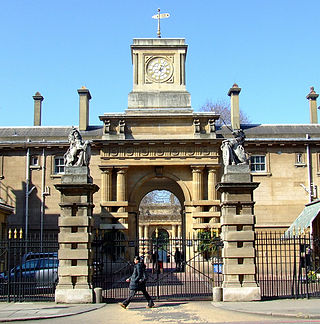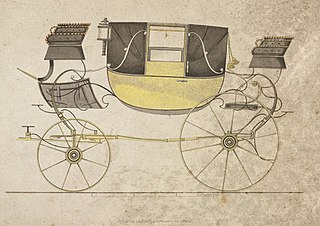
Crown jewels are the objects of metalwork and jewellery in the regalia of a current or former monarchy. They are often used for the coronation of a monarch and a few other ceremonial occasions. A monarch may often be shown wearing them in portraits, as they symbolize the power and continuity of the monarchy. Additions to them may be made, but, since medieval times, the existing items have been typically passed down unchanged, symbolizing the continuity of a monarchy.

A crown is a traditional form of head adornment, or hat, worn by monarchs as a symbol of their power and dignity. A crown is often, by extension, a symbol of the monarch's government or items endorsed by it. The word itself is used, particularly in Commonwealth countries, as an abstract name for the monarchy itself as distinct from the individual who inhabits it. A specific type of crown is employed in heraldry under strict rules. Indeed, some monarchies never had a physical crown, just a heraldic representation, as in the constitutional kingdom of Belgium.

The Royal Mews is a mews, or collection of equestrian stables, of the British royal family. In London these stables and stable-hands' quarters have occupied two main sites in turn, being located at first on the north side of Charing Cross, and then within the grounds of Buckingham Palace.

The Crown Jewels of the United Kingdom, originally the Crown Jewels of England, are a collection of royal ceremonial objects kept in the Jewel House at the Tower of London, which include the coronation regalia and vestments worn by British monarchs.
A royal train is a set of railway carriages dedicated for the use of the king or other members of a royal family. Most monarchies with a railway system employ a set of royal carriages. If the monarch is an emperor the proper term is imperial train.

The Irish State Coach is an enclosed, four-horse-drawn carriage used by the British Royal Family. It is the traditional horse-drawn coach in which the British monarch travels from Buckingham Palace to the Palace of Westminster to formally open the new legislative session of the UK Parliament.

Danish Crown Regalia are the symbols of the Danish monarchy. They consist of three crowns, a sceptre, globus cruciger, the sword of state and an ampulla . The Danish Royal Regalia are kept in the treasury at Rosenborg Castle. The oldest of these is Christian III's sword of state from 1551. They further include King Christian IV's diamond; pearl- and gold-embroidered saddles; objects carved from ivory and rock-crystal; lapidary pieces of precious stones, and brooches in the form of fantastic animals.

The Gold State Coach is an enclosed, eight-horse-drawn carriage used by the British royal family. Commissioned in 1760 by Francis Rawdon-Hastings, 1st Marquess of Hastings for King George III, and designed by Sir William Chambers, it was built in the London workshops of Samuel Butler. It was commissioned for £7,562. It was built for George III's coronation in 1761, but was not ready in time; it was completed in 1762.
The Royal Crown of Serbia is a royal regalia that existed during the Serbian monarchy.

The Golden Coach is a coach owned and used by the Dutch royal family. The Golden Coach was used every year to carry the Dutch monarch from the Noordeinde Palace to the Ridderzaal in order to deliver the Speech from the Throne or the wedding of the Prince of Orange or the Princess of Orange. The Golden Coach is stored at the Royal Stables on the Noordeinde Palace grounds in The Hague.

In coachbuilding, a landau is a four-wheeled carriage with a roof that can be let down. It was a luxury carriage. The low shell of the landau provides maximal visibility of the occupants and their clothing, a feature that makes a landau still a popular choice for Lord Mayors in the United Kingdom on ceremonial occasions.

A coach is a large, closed, four-wheeled, passenger-carrying vehicle or carriage usually drawn by two or more horses controlled by a coachman, a postilion, or both. A coach has doors in its sides and a front and a back seat inside. The driver has a raised seat in front of the carriage to allow better vision. It is often called a box, box seat, or coach box. There are many types of coaches depending on the vehicle's purpose.

The Imperial Coach is the gilded state coach that was used at the Imperial and Imperial Austrian court in Vienna. It is now kept in the Imperial Carriage Museum at Schönbrunn Palace.

The Imperial Carriage Museum is a museum of carriages and vehicles used by the imperial household of the Holy Roman Empire, the Austrian Empire and Austria-Hungary. It is housed in the grounds of the Schloss Schönbrunn in the Hietzing district of Vienna and is a department of the Kunsthistorisches Museum.

The United Kingdom's 1902 State Landau is a horse-drawn carriage with a flexible leather hoods which drop.

Coronations were previously held in the monarchies of Europe. The United Kingdom is the only monarchy in Europe that still practises coronations. Other European monarchies either have replaced coronations with simpler ceremonies to mark an accession or have never practised them. Most monarchies today only require a simple oath to be taken in the presence of the country's legislature.

The Coronation Chair of Denmark is the chair formerly used in the coronation of the Danish monarch.

The Golden Coupé, also known as State Coach No. 1, is the finest of the carriages still used by the Danish royal family. Built in Henry Fife's Copenhagen workshop in 1839–1840, it was first used by Christian VIII. Since then, it has been used by all Danish monarchs. It is used today by Margrethe II for the annual New Year's levee in January as well as for special occasions, such as jubilees and state visits.
Oberhofmeister of the Austrian King and Emperor was the most important function at the court of the Holy Roman Emperor and the Emperor of Austria in Vienna (1804–1918). The Oberhofmeister acted as the direct head of the imperial court and household and was as such very influential.


















